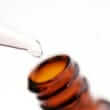Background
- Ambrette (Abelmoschus moschatus) is an aromatic medicinal shrub native to India. It is in the Malvaceae family and is related to A. esculentus, which is common okra.
- Ambrette seeds have traditionally been used to treat a wide variety of ailments and are also used in cosmetics and food. The roots and leaves are sometimes cultivated for medicinal or industrial purposes. The oil from the seeds is used worldwide in perfumes and to flavor food. The scented oil was often described as woody and floral, similar to musk, an animal product extracted from the sex glands of the musk deer. Reportedly, this musk substitute was often used as an aphrodisiac to release sexual inhibitions.
- In folk medicine, ambrette has reportedly been used as an insecticide and for wound healing, ingestion, heart disease, intestinal disorders, itching, skin conditions, stomatitis, thirst, urinary discharge, and vomiting. Ambrette seeds, roots, and leaves have reportedly been used to cure gonorrhea.
- Ambrette seeds are commonly used medicinally in India and throughout the Caribbean as a tea or tincture. Traditional medicine in India has multiple uses for ambrette, while in the Caribbean it is primarily used to treat problems related to the female reproductive system and for childbirth. Early evidence suggests that a substance in ambrette may help regulate sugar levels; however, additional study is needed in this area.
References
Natural Standard developed the above evidence-based information based on a thorough systematic review of the available scientific articles. For comprehensive information about alternative and complementary therapies on the professional level, go to . Selected references are listed below.
- Giovinazzo, V. J., Harber, L. C., Armstrong, R. B., et al. Photoallergic contact dermatitis to musk ambrette. Clinical report of two patients with persistent light reactor patterns. J.Am.Acad.Dermatol. 1980;3(4):384-393.
View Abstract - Lans, C. Ethnomedicines used in Trinidad and Tobago for reproductive problems. J.Ethnobiol.Ethnomed. 2007;3:13.
View Abstract - Liu, I. M., Liou, S. S., Lan, T. W., et al. Myricetin as the active principle of Abelmoschus moschatus to lower plasma glucose in streptozotocin-induced diabetic rats. Planta Med. 2005;71(7):617-621.
View Abstract - Liu, I. M., Tzeng, T. F., Liou, S. S., et al. Improvement of insulin sensitivity in obese Zucker rats by myricetin extracted from Abelmoschus moschatus. Planta Med. 2007;73(10):1054-1060.
View Abstract - Wojnarowska, F. and Calnan, C. D. Contact and photocontact allergy to musk ambrette. Br.J.Dermatol. 1986;114(6):667-675.
View Abstract







